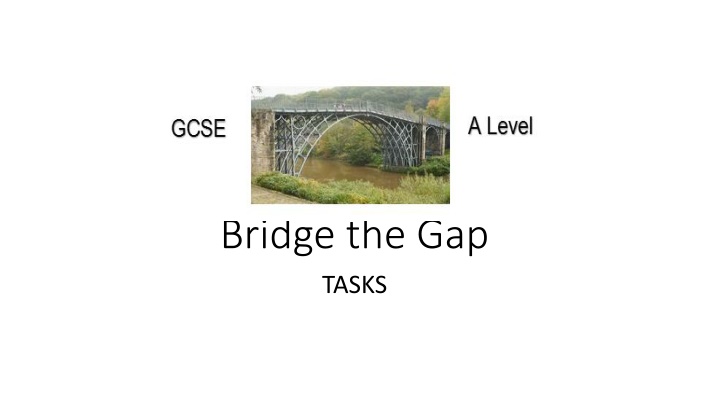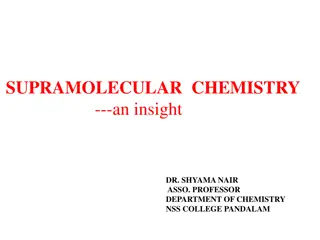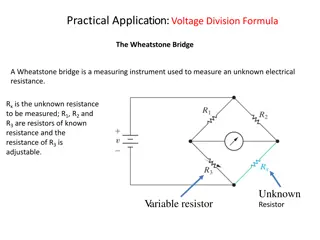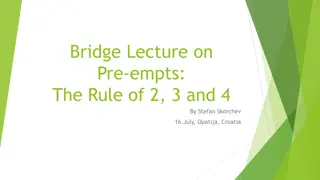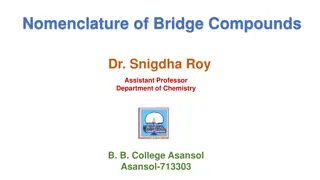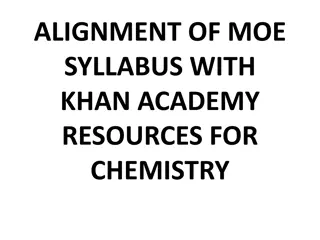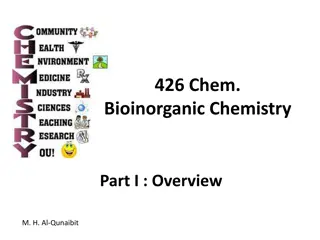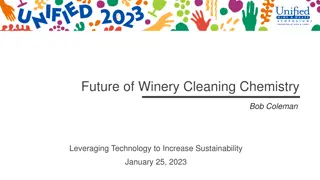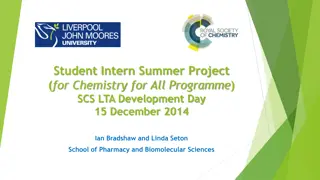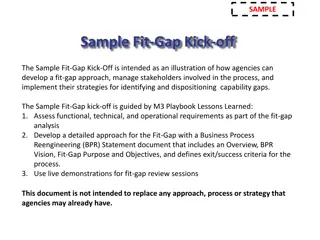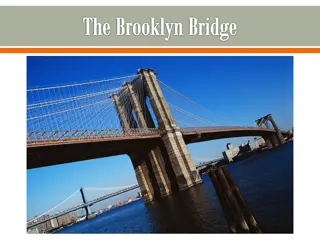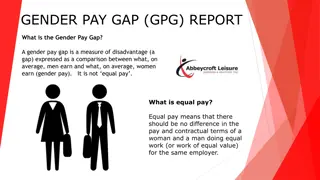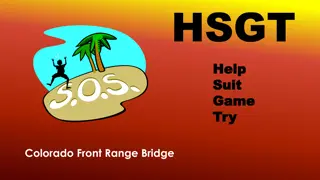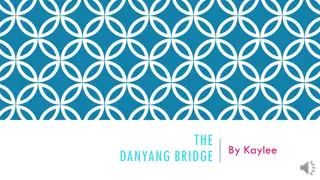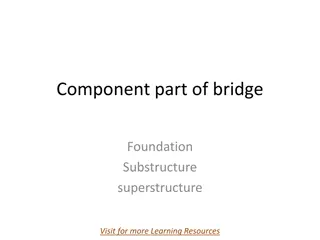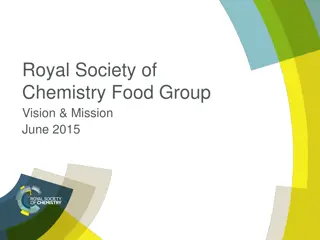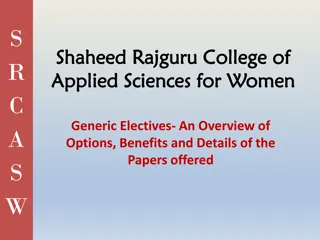Bridge the Gap
Prepare for a successful transition to A Level Chemistry with a pack of tasks covering key concepts like balanced chemical equations, mole calculations, periodic table trends, and more. Miss Foulkes encourages Y11 students to complete the tasks to refresh their GCSE knowledge and boost confidence for the Advanced course. Explore the provided resources and assessment objectives to enhance your understanding of fundamental Chemistry principles.
Download Presentation

Please find below an Image/Link to download the presentation.
The content on the website is provided AS IS for your information and personal use only. It may not be sold, licensed, or shared on other websites without obtaining consent from the author.If you encounter any issues during the download, it is possible that the publisher has removed the file from their server.
You are allowed to download the files provided on this website for personal or commercial use, subject to the condition that they are used lawfully. All files are the property of their respective owners.
The content on the website is provided AS IS for your information and personal use only. It may not be sold, licensed, or shared on other websites without obtaining consent from the author.
E N D
Presentation Transcript
Bridge the Gap TASKS
Dear Y11 student, You have had an unprecedented year so far but the school is determined to make the most of the situation to ensure that you come into the Sixth Form ready and well prepared for A Levels. The 4 units you will study in the first year of A level Chemistry are: Module 1 Development of practical skills in chemistry Module 2 Foundations in chemistry Module 3 Periodic table and energy Module 4 Core organic chemistry You can find out more about the A level specification using the link below: https://www.ocr.org.uk/Images/171750-specification-accredited-as-level- gce-chemistry-a-h032.pdf
Between now and the start of Sixth Form in September, you should aim to complete the pack of tasks below. After completing this pack you will have refreshed your knowledge and understanding of the basic concepts of Chemistry that you covered during your GCSE programme so you will be more confident tackling the Advanced course. All the very best, Miss Foulkes lfoulkes@ttsonline.net
Assessment Objectives You should be able to: write balanced chemical equations for reactions carry out mole calculations to work out relative atomic mass, molar volumes, concentrations describe the arrangement of particles in the atom describe the trends of reactions of groups in the periodic table identify oxidation and reduction reactions recognise simple organic molecules and be able to draw structures of alkanes and alkenes describe chemical reactions as endothermic or exothermic and draw energy level diagrams explain the difference between ionic and covalent bonding and draw dot and cross diagrams
Task 1 - Writing Balanced Chemical Equations Work through this exercise to write and balance 12 chemical equations a) zinc and sulphur combine to form zinc sulphide b) copper reacts with oxygen to form copper oxide c) sulphur and oxygen form sulphur dioxide d) magnesium carbonate decomposes to form magnesium oxide and carbon dioxide e) hydrogen and copper(II)oxide form copper and water f) carbon and carbon dioxide react to form carbon monoxide g) magnesium reacts with sulphuric acid to form hydrogen and magnesium sulphate h) calcium reacts with water to form hydrogen and a solution of calcium hydroxide i) zinc reacts with steam to form hydrogen and zinc oxide j) aluminium and chlorine react to form aluminium chloride k) copper and chlorine combine to form copper(II)chloride CuCl2 RESOURCES Rules for writing chemical equations PowerPoint www.Kerboodle.com
Task 2 - Mole Calculations Have a go at these differentiated mole calculations on the following 3 slides RESOURCES OLC www.kerboodle.com
Easy 1. Write pyramids for the two equations 2. How many moles are there in 23 g of 23Na? 3. How many atoms are there in 1 mole? ii) How many atoms are there in 0.5 moles? 4. How many moles are there in 120 g of Calcium? 5. What is the mass of 2 moles of 238U? 6. What is the volume of 4 moles of He(g)? 7. A gas has a volume of 120 dm3, how many moles is this? 8. What is the Mr of a substance where 1 mole has a mass of 11 g? 9. What is the concentration of a solution with 2 moles dissolved in 1 dm3? 10. What would the concentration be if 3 moles where dissolved in 3 dm3?
Medium 1. 2. 3. 4. 5. 6. 7. How many moles are there in 44 g of CO2? How many molecules is this? How many molecules are there in 79 g of Fe2O3? How many atoms id this? What is the mass of 2.5 moles of Na2O? What is mass of 2.34 moles of Platinum? How many moles are there in 132 g of CO2? How many dm3would this be? 58.5 g of sodium chloride are dissolved in 1 dm3. What concentration would this be? How many moles would needed to be dissolved in 1 dm3to get a 3M solution? How many would be needed if only 0.1 dm3were used? 92 dm3of a gas dissolved in a solvent. How many moles is this? What is the concentration of the resulting solution? 48 dm3of a gas has a mass of 262 grams. How many moles is this? What is the Mr? What must this element be? 8. 9.
Hard 1. 2. 3. How many molecules are there in 79 g of Fe2O3? How many atoms is this? How many moles are there in 132 g of CO2? How many dm3would this be? 58.5 g of sodium iodide are dissolved in 0.5 dm3. What concentration would this be? 392 dm3of a gas are dissolved in 2.65 dm3of a solvent. What is the concentration of the resulting solution? 48 dm3of a gas has a mass of 262 grams. How many moles is this? What is the Mr? What must this element be? 1.2 x 1024molecules are dissolved in 670 ml, what is the concentration? A metal reacts with 8 g of oxygen molecules to form 15 g of a basic oxide. What is the metal? Remember metal oxides are M2O, MO or M2O3(M = Metal ion). 1.24 g of calcium carbonate is reacted with 15 ml of 1 M hydrochloric acid. How many dm3of gas are formed? How many atoms are there in this gas? 4. 5. 6. 7. 8.
Task 3 - Atomic Structure & Periodic Table 1. Write a definition for the terms atomic number and mass number. 2. Write down full electronic configurations for the first 20 elements. 3. Relate the electronic configurations to the position of the element in the Periodic table in terms of group and period. You will need to use a Periodic table to help you with this task RESOURCES Periodic table OLC www.kerboodle.com
Task 4 - Reactivity of Group 1, 7 & 8 Elements Describe how the reactivity of the elements in groups I, VII & VIII changes with atomic number. Use electronic structure/shielding and distance from the nucleus to help explain your answers. RESOURCES OLC www.kerboodle.com
Task 5 - Oxidation & Reduction 1. Write a definition for the terms oxidation and reduction. 2. Complete the exercise to identify oxidising and reducing agents. For each example below state; the oxidising agent the reducing agent what has been reduced what has been oxidised RESOURCES OLC www.kerboodle.com a) the thermit reaction aluminium + iron oxide iron + aluminium oxide b) roasting the ore tin sulphide in air tin sulphide + oxygen tin oxide + sulphur dioxide c) smelting tin oxide with coke tin oxide + carbon tin + carbon monoxide d) roasting the ore copper sulphide in air 2CuS(s) + 3O2 2CuO(s) + 2SO2(g)
Task 6 - Hydrocarbons 1. What is a hydrocarbon? Explain this in one sentence 2. Draw the structures of methane, ethane, ethene. 3. Explain which are saturated and which are unsaturated. RESOURCES www.kerboodle.com OLC
Task 7 Energy Draw energy level diagrams for both endothermic and exothermic reactions making sure that they have been labelled correctly. Label activation energy on your diagrams and explain this term RESOURCES www.kerboodle.com OLC
Task 8 Chemical bonding 1. Write definitions for ionic and covalent bonding. 2. Draw dot and cross diagrams for the ionic compounds sodium chloride, magnesium oxide and aluminium fluoride. 3. Draw dot and cross diagrams for a hydrogen molecule, a chlorine molecule, carbon dioxide and ethene. RESOURCES www.kerboodle.com OLC
Answers If you would like the answers to the tasks to check your understanding please email me at: lfoulkes@ttsonline.net
